David Linkie looks back to a day spent with Filey skipper Brian Cox on the Scarborough trawler Cara Lee in November 2011
Thirty minutes after leaving Scarborough harbour, the rhythmic beat of Cara Lee’s Gardner 6LXB engine slowed to a burble when skipper Brian Cox eased back the handle in preparation for shooting.
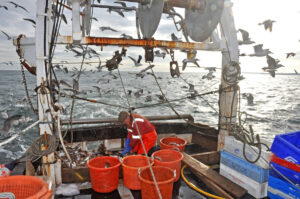
Single-handed skipper Brian Cox sorting the first haul on Cara Lee.
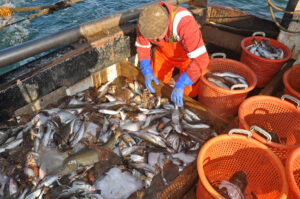
Selecting fish out of the deck pond.
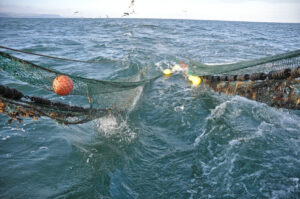
The toe-ends of the net are hauled back to the trawl gantry…
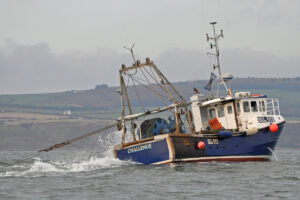
Single-handed skipper Jamie Cox’s Challenge towing into the northwest towards Fraggle Rock.

NEIFCA’s fisheries patrol vessel North Eastern Guardian III heading south between Cara Lee and Scarborough Castle.
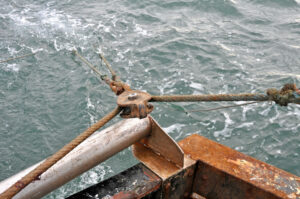
Coming round on the gear.

A free-running sheave on a transom bridle gave Cara Lee a low and self-aligning towing point.

Cara Lee returning to Scarborough from the inshore grounds.
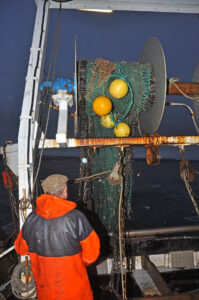
Brian Cox shooting a 72ft Rye Bay cover trawl off the starboard net drum.
With Cara Lee having been forced back to harbour the previous morning after the first haul by a freshening southerly wind, the trawl was neatly wound on the elevated net drum, as a result of Brian Cox using the extra time ashore to shake the net clean of weed and check it over for damage before taking it back onto the starboard drum.
Targeting a mix of prime fish, including Dovers, brill and turbot, together with whiting and the occasional sprinkling of green on sandy ground off Scarborough, the under-10m Cara Lee used a 72ft Rye Bay cover trawl rigged on a 3in rubber footrope with drop chains in the bosom section.
Until a few years earlier, when a similarly rigged trawl arrived on the former under-10m Rye trawler Orca RX 380 when skipper Mick Sharp moved to Scarborough, Yorkshire inshore skippers traditionally used bare chain. With the rubber footrope proving to be more forgiving in terms of getting over an area of hard sand or shady bottom, local skippers subsequently adopted this method of rigging their light trawls.
With the net smoothly disappearing astern into the lingering darkness shortly before 7am on a wet early November morning, skipper Brian Cox quickly clicked on the sweeps before releasing the net drum pennants. Spread by a set of 5ft Vee doors, Cara Lee’s sweeps consisted of eight-fathoms splits and nine fathoms of 22mm combination. Seventy fathoms of 12mm wire were run off the outer drums of the North Sea Winches three-drum trawl winch before the brakes were applied.
A couple of Scarborough trawlers fitted with bigger engines worked 90ft versions of the Rye Bay cover nets, together with 15-fathom splits, in order to give more headline height.
On attaching towing chains to the wires, skipper Brian Cox clipped a bridle, attached to either leg of the trawl gantry, across the transom. Supporting a free-running sheave to which short towing strops were attached, this arrangement gave a low towing point below the transom rail, at the same time as allowing the warps to take up an optimum position when Cara Lee turned.
Having shot in 20 fathoms two and a half miles east of Scarborough, Cara Lee towed slowly north into the flood tide at 1.7 knots, with the 127hp Gardner engine running at 1,150rpm. In targeting higher-value prime, Brian Cox preferred a slow towing speed. Driving a 34in-diameter four-bladed propeller through a Self-Change 3:1 reduction box and steaming at under 1,500rpm, Cara Lee returned a fuel consumption of nine to 10 litres an hour – a frugal rate which played a key part in achieving a viable economic return from low-impact fishing.
As the early-morning rainclouds began to clear away, the four other inshore trawlers that had left Scarborough harbour at 6am – CJ Lewis, Challenge, Mairi Kelly and Provider – could be seen towing closer inshore, one and a half miles to the north, in an area that usually yielded mainly groundfish. Shortly after Cara Lee had settled into the tow as an initially lumpy sea fell away, the NEIFCA fisheries patrol vessel North Eastern Guardian III steamed past heading south, having left Whitby on the first bridge.
Having found a reasonable showing of good-quality whiting slightly further out 48 hours earlier, together with a small amount of groundfish, Brian Cox had opted to return to the same area, partly influenced by the fact that with light whitefish markets in northeast Scotland, round whiting were making 80p-£1 on Scarborough market. After towing up to a wreck displayed on the Simrad CX44 plotter, Cara Lee came round to port to take the last hour of the tow on a reciprocal southerly heading.
Shortly after a fine breakfast of fried haddock and dabs, the hydraulics were clutched in after the gear had been down for two and three-quarter hours. With the toe-ends hauled back to the gantry, Brian Cox clipped on an extension to the dog rope before using the whipping drum to haul the bag to the starboard quarter, where it was lifted aboard.
On releasing the codline, whiting dominated the fish that tumbled into the deck pond. While there were also a few codling, a couple of brill and a good-sized turbot, Dover soles were conspicuous by their absence.
The lack of Dovers, both in the pond and as stickers meshed in the bag and needing to be picked out, initially surprised skipper Brian Cox, until he noticed two soles with their heads ripped off – the result of a marauding seal having enjoyed a tasty free breakfast after latching onto the trawl.
Although reasonably pleased with the quantity of whiting, with the added bonus of a few codling, Brian Cox was disappointed by the lack of prime, so he decided to begin the second tow heading into the northwest and slightly shallower water, for which he shot 10 fathoms less wire.
Having hauled at the same time, the signs from the other Scarborough boats were not particular encouraging, as they could now be seen towing out into the southeast and deeper water. With Cara Lee heading in the opposite direction, this was an indication that the skippers were unsure whether to stick or twist – at least some things never change in fishing!
Picking the catch off the deck resulted in Brian Cox washing and boxing 10st of round whiting and 2st of green, but very little prime. On Challenge, Brian Cox’s son Jamie reported 1½st of Dovers and a similar amount of cod, but only half a basket of whiting. Similar results were received from the skippers of the other three boats.
After towing with the first of the ebb for 90 minutes and then easing through between two wrecks in 17 fathoms, skipper Brian Cox altered the Simrad AP35 autopilot to haul Cara Lee round to starboard before towing out into the southeast, as the rest of the fleet continued heading into the northwest before towing round the Fraggle Rock looking for a few codling.
On returning to sea three days earlier after a heavy southeasterly sea had left favourable conditions of thick water, the inshore trawlers had landed a few boxes of cod for their day’s work, but this catch rate had quickly dropped off as the water cleared.
A second uneventful tow ended after two and a half hours, when the codend was brought towards the transom to reveal a slightly better bulk of whiting, together with a few more Dovers. Opening the codend revealed that most of the whiting had been caught towards the end of the tow, suggesting that the decision by skipper Brian Cox had been a correct one.
On retying the codline shortly before 1pm, he took the first leg of the final tow into the southeast in a similar area to where most of the whiting were thought to have been taken towards the close of the second drag, before coming round to starboard and heading towards the distinctive landmark of Scarborough Castle – a move that would shorten the steaming distance back to harbour at the end of the third haul.
Steadily working away to empty a full deck pond resulted in Brian Cox washing seven baskets of round whiting before starting to gut a few codling and Dovers. Challenge’s second haul had yielded three boxes of whiting, 1st of prime and 4st of green.
Although single-handed trawling is widely recognised as being difficult, by using a lifetime’s experience of inshore fishing and sticking to a well-established routine, Brian Cox succeeded in making it look deceptively easily – which, of course, is usually a good indication of a highly skilled professional.
One advantage shared by the Scarborough inshore trawling fleet was that nearly all of their fishing could be carried out within five to six miles of harbour, and when the need arose, within one mile of the land. This takes the form of substantial cliffs, particularly north of the harbour, meaning that skippers could sometimes put in a day’s work during a gale of wind off the land.
Equally, however, fishing days were frequently lost to sea winds, which had been increasingly frequent in the previous two years. The extent to which fishing on the exposed east coast of England was regularly constrained by unsuitable conditions is shown by the fact that this trip only took place at the third time of asking, after two earlier planned attempts were blown out of the water. This was only the second full day’s fishing that Brian Cox had been able to put in during the previous seven, while another six days would pass before Cara Lee left harbour again.
Brought to a halt just over a mile offshore from Scarborough Castle, the third tow yielded a similar quantity of whiting to the first, but with a few more Dovers, together with a couple of brill and squid and some codling – some of which might have been in the tunnel from earlier hauls.
After lying in Scarborough bay for 15 minutes to finish off gutting and boxing, skipper Brian Cox eased Cara Lee alongside the quay under Scarborough fishmarket shortly before 4pm, as a fairly typical day for a single-handed inshore trawler drew to a close.
The last piece in the jigsaw involved Brian Cox weighing in, boxing and icing 350kg of round whiting, 35kg of green and 14kg of prime, before the top-quality fish, all of which had been caught in the preceding nine hours, was put into the chill overnight, ready for the 7.30am auction the following morning, when cod made over £2.50 per kg, sole £5-6, turbot £8-10 and round whiting 82p per kg.
Cara Lee
The under-10m trawler Cara Lee BRD 625 arrived at Scarborough in March 2011, when Brian Cox bought the GRP-hulled vessel from Dennis Huggins of Sheerness.
Based on a Marislock GRP hull designed by Roy Bently and moulded by Gordon Evans of Marislock Ltd, Morpeth Dock, Birkenhead, Cara Lee was built in the early 1980s as the Lady Jen BS 234 for John Hughes of Llandudno Junction and fitted out by the owner at Deganwy docks.
Lady Jen was one of four similar boats that Marislock Ltd completed at this time for local skippers, the others being Calabar LL 3, Yat Ding Ho LL 146 and River Island.
Subsequently reduced in length to under 10m, the vessel was bought by George Wilson of Dunvegan, Skye, in 1997 as Trust SN 348 from Don McNeil of North Shields, and renamed Cara Lee BRD 625. Rigged for scalloping, Cara Lee was bought by Pwllheli skipper Mike Jones in 1999. Nearly 10 years later, Cara Lee moved to southeast England when bought by Dennis Huggins, before being extensively refurbished.
Skipper reflects on half a century of change
Having spent 50 years fishing by the time of this trip, Filey skipper Brian Cox reflected on the largescale changes that he had lived through and adjusted to during a career that included potting, longlining, gill-netting and trawling.
Born at Filey, a traditional inshore fishing community five miles south of Scarborough, Brian Cox spent a few years crewing on beach-launched cobles before, at the age of 27, placing an order with local boatbuilder Gordon Clarkson for the 30ft Yorkshire coble Challenge SH 193.
In addition to potting, skipper Brain Cox regularly went lining for dogfish with Challenge, working up to 12 lines, each of 200 hooks. While 200-250st catches of dogs were fairly common, on one occasion, after particularly heavy fishing, Challenge returned to Filey coble landing with just one plank out of the water, after catching what turned out to be 96 boxes of dogfish (approximately 500st).
Seeing the potential for lining, in 1976 Brian Cox bought the 44ft Magdalene Ann CT 33, built by Nobles of Girvan in 1960, from Jim McFarlane of Islay. The boat was also used for trawling, skippered by Brian Nicholson of Scarborough. After returning to coble fishing for a few years, Brian Cox subsequently bought the 52ft Intrepid OB 280, built at Macduff in 1958 as the seine-netter Transcend BCK 75, from Oban. Renaming it Challenge SH 263 after his coble, Brian Cox used this boat for gill-netting, both over wrecks and over hard ground during the winter months, as well as for trawling.
With the onset of quota problems, Challenge was converted to potting by Parkol Marine Engineering at Whitby, when a new wheelhouse was also fitted. On moving his operating base south to Bridlington in the early 1990s, Brian Cox spent some time whelking, steaming up to 45 miles to grounds off the Humber and making three 36-hour trips a week.
After selling Challenge to Mick Barker of Bridlington, Brian Cox moved into inshore trawling. This led to the purchase of the under-10m steel-hulled trawler Tamarlyn from Fife skipper Tommy Gordon, which Brian Cox renamed Jo Dan C SH 279 after his first grandson.
Following the sale of this boat to Newlyn skipper Kevin Curtis, Brian Cox downsized again on buying Calypso NN 135, a Colvic 31, from Clint Davies of Wales. This boat was subsequently replaced with the aptly named under-10m trawler Challenge II from Blyth.
Challenge II was decommissioned in 2009 before being replaced with Autumn Rose KY 30, a Buccaneer 21 potter, which Brian Cox sold to Boscastle before buying Cara Lee earlier in 2011.
Not long after this trip, skipper Brian Cox called time on single-handed trawling by selling Cara Lee and replacing the boat with a smaller potter, which he worked for a couple of years until finally stepping ashore.








